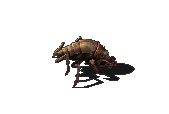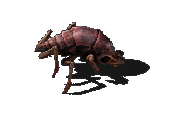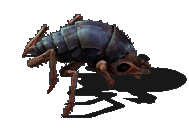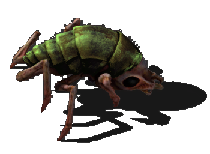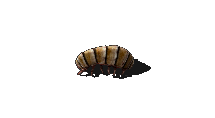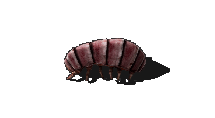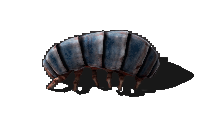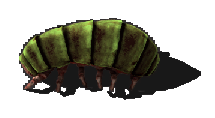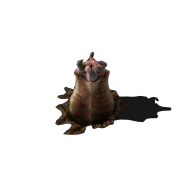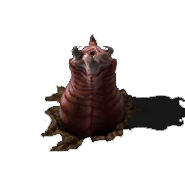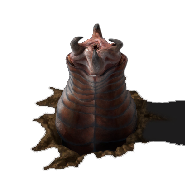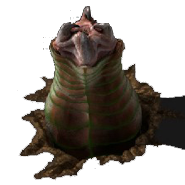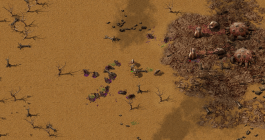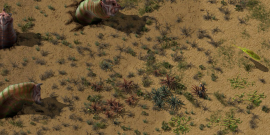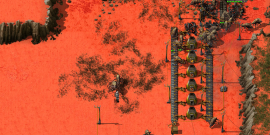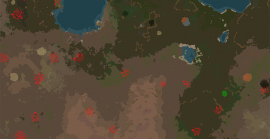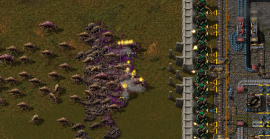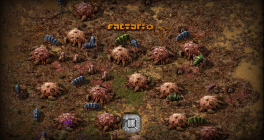Вороги
| Ця стаття є заготовкою і не є завершеною. |
|---|
| Ви можете допомогти проєкту, доробивши її. |
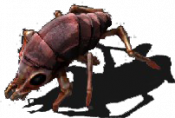
Вороги (також часто називають Кусаки або в оригіналі Biters) це істоти, які хочуть завдати шкоди гравцю. Вони є корінними мешканцями позаземного світу у вигляді членистоногих, що живуть у органічних гніздах, мирно співіснуючи один з одним. Вони бувають трьох видів: кусаки, плюваки та черв'яки. Види надалі розрізняються на чотири стадії росту, а отже, і сили. Вороги та гнізда відображаються на карті як червоні крапки. Так само, як і гравець, вороги можуть повільно відновлювати втрачене здоров’я.
Досягнення
Вороги безпосередньо пов’язані з наступними досягненнями:

|
It stinks and they don't like it Викликати атаку жуків через забруднення. |

|
Задавлено Знищити 10 лігв тараном. |
Істоти
Кусаки
Кусаки - один з двох основних антагоністів у грі. Вони бувають чотирьох розмірів: маленькі, середні, великі та велетеньські. На початку гри будуть тільки маленькі. Зі збільшенням забруднення, вони стануть більшими, що пов’язано з еволюцією ворога. Як може здатись з назви їх основний і єдиний спосіб атаки це "кусати".
Плюваки
Плюваки дуже схожі на кусак і з'являються трохи пізніше у грі, коли фактор еволюції зростає. Їх основна відмінність від кусак - це дистанційні атаки. Визначаючи траєкторію пострілу заздалегіть, вони плюють струменем кислоти, який тимчасово залишається на землі після влучання. Завдяки прогнозуванню плювків, струменя кислоти можна уникнути, раптово змінивши напрямок ходьби або стоячи на місці[1]. Як струмінь, так і калюжа кислоти завдають шкоди часу і уповільнюють гравців та транспортні засоби. Більшість сутностей гри мають набагато менший опір кислоті, ніж інші типи пошкоджень (включаючи турель та броню), тому плюваки ефективніше проти гравця та його творінь. Їх поведінка та класифікація розміру такі ж, як у байтерів, але їх здоров'я значто нижче, і вони стійкі виключно до вибухів, немаючи фізичного опору.
Черв’яки
Черв’яки це природні союзники кусак та плювак. Вони будуть атакувати гравця, якщо той наблизяться достатньо близько для атаки. Атака схожа на атаку плювак, за виключенням, що черв'яки статичні, діють як турелі та не будуть слідувати за нападниками. Вони покладаються на високу шкоду, великий діапазон, щоб тримати гравця подалі від черв’яків та гнізд, які вони захищають. На відміну від інших ворогів, вони стійкі до вогню. Вони будуть плювати кислотою в гравця, яка також може залишити кислотні калюжі на землі, які все ще можуть завдавати шкоди гравцям та транспортним засобам, а також уповільнювати їх та завдавати періодичної шкоди кислотою, термін дії ефекту залежить від розміру. Будівлі гравця не будуть отримуватии шкоди від калюжі кислоти, але все ще будуть вразливі від прямої атаки. Черв’яки також діляться на 4 види, характеристики яких залежать від розміру. Черв’яки створюються лише під час розширення ворогів, коли виконується певний вимога до фактора еволюції. Це 0.3 для середнього черв’яка, 0.5 для великого черв’яка та 0.9 для бегемота черв’яка. Нижче цих факторів еволюції черв’яки можуть бути створені лише генерацією карти. Генерація карти обмежує черв’яків вищого рівня пропорційно відстані до початкової точки. Чим далі гравець віддаляється від початкової зони, тим сильнішими стають черв’яки.
| Зображення | Інформація |
|---|---|
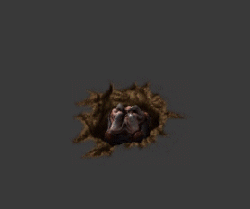 |
Анімація атаки черв'яка. |
Гнізда
Це точки появи кусак та плювак. Хоча самі гнізда зазвичай беззахисні, вороги, яких вони породжують з часом, ефективно служать як форма оборони. Часто біля гнізд такоє є і черв'яки, які виконують роль стаціонарної оборони. Гнізда, які піддаються забрудненню, використовують його, щоб породити ворогів, які будуть здійснювати атаку. Вороги, які не беруть участь у бою, можуть шукати найближче гніздо для захисту.
Гнізда мають високу стійкі до вогню та стійкіні, ніж середній черв’як.
| Зображення | Назва | Інформація |
|---|---|---|
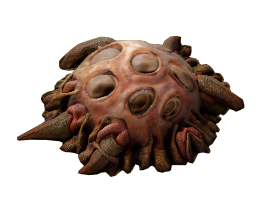 |
Гніздо кусака |
Стійкість:
|
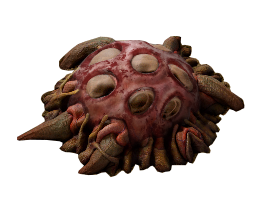 |
Гніздо плювака |
Стійкість:
|
Експансія
Кожні 4-60 хвилин група з 5-20 кусак/плювак залишає свою базу, щоб створити нову базу, яка складатиметься з такої ж кількості черв’яків/гнізд, як і кількість учасників у групі. Ця група шукає підходяще місце, яке знаходиться на відстані 3-7 квадратів від існуючих баз. Інтервал між розширеннями ворогів є глобальним, і чим вищий фактор еволюції ворога, тим коротший середній інтервал. Більше того, чим більша еволюція, тим більша група.
Як тільки вони знайдуть підходяще місце, кожен кусака/плювака у групі гине і формує нове гніздо або черв’яка. Формування нового гнізда або черв’яка знищить все, що перешкоджає його створеню, що включає і учасників групи розширення. Є затримка між кожним учасником, який жертвує собою, щоб створити черв’яка/гніздо, тому створення нової бази з групи розширення може зайняти досить багато часу, залежно від розміру групи. Середні черв’яки формуються лише за умови, що поточна еволюція вища за 0.3, великі черв’яки - лише якщо поточна еволюція вища за 0.5, а гіганські черв’яки - лише якщо поточна еволюція вища за 0.9. Гра випадковим чином вибирає, чи формувати нове гніздо кусак, гніздо плювак, маленького черв’яка або більшого черв’яка, якщо фактор еволюції достатньо високий[2]. Цей параметр можна вимкнути у налаштуваннях, також у залізнодорожньому світі цей параметр вимкнено за замовчуванням
Defense
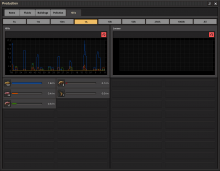
Nests spawn biters and spitters freely. However, biters and spitters will only aggressively engage the player's factory if the pollution cloud of the factory reaches a nest because pollution is consumed to send biters or spitters to join the next attack. Every 1 to 10 minutes (random) the mustered biters launch an attack. If not all biters have arrived at the rendezvous point by that time, they will wait up to an additional 2 minutes for stragglers. The attack then proceeds to their target over the shortest path possible, accounting for terrain, but not for player entities that could pose an obstacle (like walls).
If there is a clear path somewhere around those obstacles, the biters will attempt to go around. If there is no clear passage or a clear passage would mean deviating too far from the original course, the biters will attack whatever is in their way to go through. This can be exploited to an extent; creating mazes at regular intervals along a barrier can direct the biters through a gauntlet not dissimilar to tower defense.
However, if a biter comes in proximity of a military unit or structure, it will prioritize these and attempt to immediately attack them instead, again trying to reach the new target over the shortest possible path with no too great detours, if possible.
Evolution
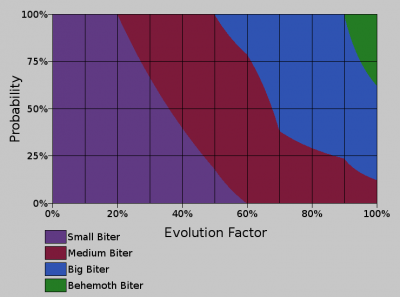
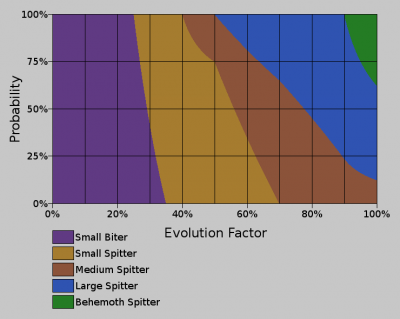
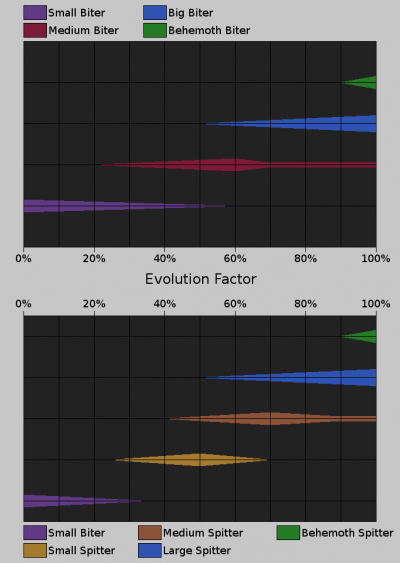
The evolution factor is a global variable that determines what kind of biters will be spawned. You can check the variable in the dev console via the following command (does not disable achievements):
/evolution
The evolution factor goes from 0 (not evolved at all) to 1 (maximal evolution). The evolution factor can only increase.
This command also provides percentages for the three sources; each one is the percent of the (unsquashed) total evolution that is contributed by that source.
Besides choosing what kind of biter will be spawned, the evolution factor also influences the spawning interval. This interval (spawning_cooldown in the enemy-spawner definition) is interpolated between 360 (0 evolution) and 150 (1 evolution) game ticks (= 6 to 2.5 seconds).
Methods of increasing
The evolution factor is increased by three kinds of events:
- The passage of time very slightly increases the evolution factor.
- The global pollution production increases the evolution factor.
- Destroying nests significantly increases the evolution factor.
The default settings are:
| Source per | Variable in enemy_evolution
|
Evolution increase |
|---|---|---|
| Second | time_factor |
0.000004 |
| Destroyed enemy spawner | destroy_factor |
0.002 |
| 1 Pollution unit | pollution_factor |
0.0000009 |
These values can be set during world generation: the values in the dialog box are multiplied by 10^-7 for time and pollution, and 10^-5 for spawner destruction. In game, they can be found in game.map_settings.enemy_evolution, though checking or modifying them is considered using cheats.
Pollution production is the total pollution produced by buildings, not the pollution spreading on the map, so it is not reduced by trees or other absorbers. e.g. : 10 boilers produce 300 pollution in one minute, raising the evolution factor by around 0.00027 in that minute.
After totaling up all the evolution from these sources, this quantity is squashed to fit in the range [0, 1) by applying evolution_factor = total_evolution / (1 + total_evolution).
Equivalently, marginal increases in evolution are reduced by multiplying the increase by (1 - evolution_factor)². So for instance destroying enemy spawners in the beginning of the game results in increase of evolution factor by 0.002 while doing this when the evolution factor is 0.5 the increase is only 0.0005.
This also means that the evolution factor approaches 1 asymptotically - generally, increases past 0.9 or so are very slow and the number never actually reaches 1.0.
Spawn chances by evolution factor
The probability charts show the chances of each type of biter/spitter for each spawner at all evolution levels.
Advanced: Evolution factor components and computation
This section has charts plotting the individual evolution factor components and discusses possibilities for manually estimating the evolution factor.
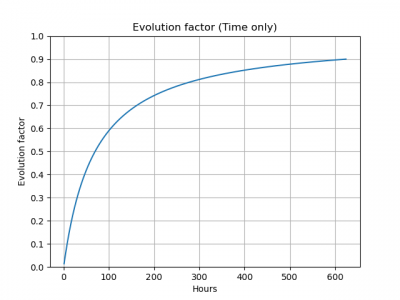
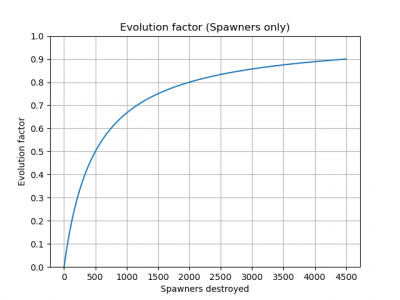
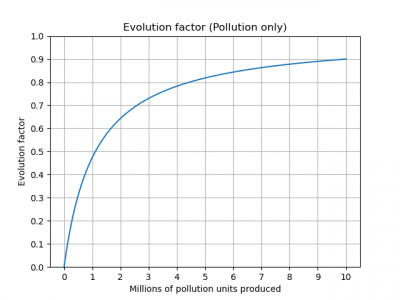
Notes
- Data from version 1.1.50.
- All charts end at approximately an evolution factor of 0.90.
- The calculation steps for time and spawner kills match those used by the game, so these charts should be accurate. The pollution chart assumes a pollution production of 1000 units per second, and due to the recursive nature of the chart values will slightly diverge at different pollution rates. The effect of this is negligible for any reasonable amount pollution production, however.
- Given that the game reports the actual evolution factor (console:
/evolution) whenever the player wishes, these charts are intended primarily to help estimate the impact of planned base expansions and similar activities on the evolution factor's future development.
Comments
These charts (click to enlarge) represent the situation where each evolution factor component (time, pollution, destroyed spawners) is the only component contributing to the evolution factor in that entire game. They are therefore not realistic, as in a typical game all three components will contribute, some at varying times and intensities.
Because of how contributions to the evolution factor (EF) are calculated (multiplied by (1 - current EF)), it is not possible to simply add the values indicated by these charts for a game's time passed, pollution generated, and / or spawners destroyed so far to retrieve the total evolution factor.
For example, if 24 hours have passed (single-component EF =~ 0.25), 200,000 pollution units were released (single-component EF =~ 0.15), and 400 spawners were destroyed (single-component EF =~ 0.45), the actual evolution factor will not be (0.25 + 0.15 + 0.45 =) ~0.85.
However, the evolution factor will always be less than the sum of all individual components as indicated by these charts, and at least as high as the highest individual component. Thus, using the values from above, the EF will be at least 0.35 and less than 0.85. A smarter approach is required to compute the current evolution factor.
Individual components
The individual components of evolution can be approximated from /evolution:
Given the evolution factor, the unsquashed evolution is unsquashed = evolution_factor / (1 - evolution_factor). Multiply this by the percentage for a given component to get its approximate unsquashed contribution. Of course, total pollution and spawner kills can also be found on the production statistics screen, and time passed can be found using the /time command, so it's not fully necessary.
The actual factors can be found in game.forces.enemy.evolution_factor_by_time, ...evolution_factor_by_killing_spawners, and ...evolution_factor_by_pollution, if you don't mind disabling achievements.
Gallery
-
The player near some enemy nests and worms.
-
The player among acid puddles created by attacking worms.
-
Both the player and some buildings getting attacked by biters.
-
Enemy nests seen in a map generation preview (deathworld setting).
-
Line of gun turrets defending against biters.
-
Enemies seen at the title screen.
History
- 0.17.0:
- Behemoth worm added.
- 0.15.0:
- Increased the damage, range, and health of worms.
- Decreased health and resist of Behemoth biters.
- 0.13.10:
- Biters and other units won't become aggressive as a result of friendly-fire.
- 0.13.0:
- Big and behemoth enemies now spawn 50% slower.
- Changed the way evolution factor approaches the maximum (1).
- The addition of evolution factor was changed from addition * (1 - evolution) to addition * (1 - evolution)^2
- This means that the progress gets more slower towards the high values.
- 0.12.26:
- Running biters over with a vehicle will now anger them in peaceful mode.
- 0.12.0:
- Updated sounds for enemies.
- 0.11.6:
- Range of spitters is now 15, less than turrets.
- 0.11.0:
- Spitters added.
- Drawing of enemies optimised, so adding new colors does not impact VRAM.
- Blood splashes on death are now procedural.
- 0.9.0:
- Turrets no longer search for enemies when none are near.
- Biters can no longer destroy the shipwreck in the 3rd new hope campaign.
- 0.8.1:
- Further improvement to enemy AI.
- 0.8.0:
- Decreased the range of medium worm from 25 to 20.
- 0.7.2:
- Biter AI improved.
- 0.7.1:
- Peaceful mode added for freeplay.
- 0.7.0:
- Enemy creepers were replaced by small, medium and big biters.
- Enemy turrets were replaced by small, medium and big shooting worms.
- Enemies move and attack in groups.
- Enemies wander around their base when they have nothing to do.
- Enemies call for help when attacked.
- Enemies can create new bases.
- Enemies can now destroy all player creations they find.
- 0.1.0:
- Introduced, called 'creepers'
